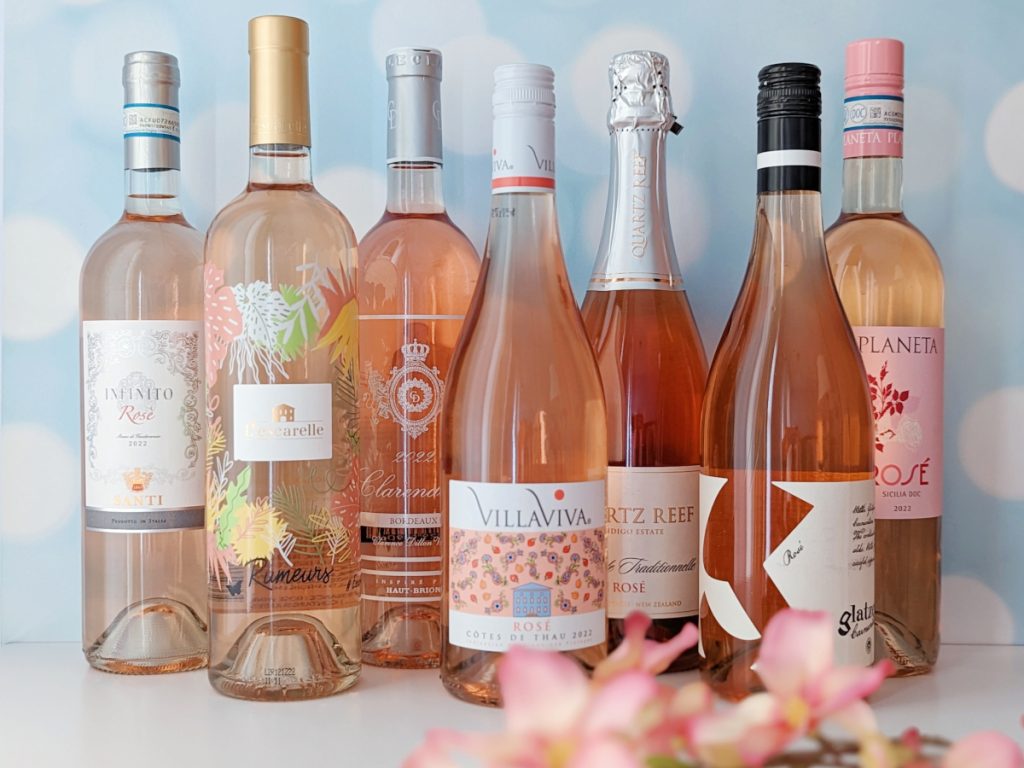Think Pink: All Things Rosé
Release Date: April 24, 2025

Photo by: Denise M. Gardner
Today, we’re diving into one of our favorite styles of wine: rosé! This style of wine has become increasingly popular over the past decade. Rosé wines have a long history of existence, but after decades of a downhill spiral, it now seems like every wine brand has a rosé wine. Want to know what goes into crafting a rosé wine? We covered it! Want to reveal those traditional rosé wine styles? We will! And, what can you, the consumer, expect when you open up the bottle? It’s time to put some truth behind modern misconceptions about rosé wine as we all lean into “thinking pink” in this episode!
Links for things mentioned in this episode:
- OIV Focus 2023 Report
- Over 21 years, both demand for rosé and production of rosé increased. Currently, rosé is about 8% of the global wine production.
- France is the highest producing rose country and highest consuming rose country. Countries that follow include the U.S., the U.K. and Germany.
- A History on Rosé Wine
- Ancient Greece was the civilization that created rosé wines by watering down red wines.
- The Ancients believed that diluting wine with water was making the wine safer. In reality, the wine (alcohol) was making the water safer.
- Provence became the epicenter of rosé wine production.
- In the 19th century (1800’s), French tourists flock to the South of France, which is generally a pretty hot region. Rosé wines became the symbol of glamour, leisure, and summer time (summer holidays!).
- Eventually, rosé fell out of popularity. It’s production and consumption dropped.
- 1975: White Zinfandel emerges from California, resurging the popularity of rosé wines. Most White Zinfandels were produced with some level of sweetness.
- In the U.S., dry rosés become more popular. (This was also during the rise of the high alcohol red wines. Its possible dry rosé wines and New Zealand Sauvignon Blanc were the counterculture to the high alcohol red wine popularity.)
- Ancient Greece was the civilization that created rosé wines by watering down red wines.
- Rosé Wine Production
- Rosé wines are made using red wine grapes. For more information, refer to the April 2021 Sip & Swirl, “Creating Rosé Wine”.
- Direct Press / Short Maceration Time – most intentional form of producing rosé wine and most common production technique for producing rosé wines.
- Saignee (“to bleed”) – a concentration technique for red wines in which removed pink-red juice is removed from the red must and fermented separately as a rosé wine.
- Blending – least common method for making a rosé style of wine (e.g., Champagne).
- Rosé wines are made using red wine grapes. For more information, refer to the April 2021 Sip & Swirl, “Creating Rosé Wine”.
- Misconceptions about Rosé Wines:
- Color Bias: “The darker the rosé wine, the sweeter it is.” – FALSE. Rosé wines vary wildly in color: from pale-almost-white colored to dark-dark pink/red… and everything in between including the traditional salmon-pink color. Color has no indication on sweetness or quality (how good the wine is) of the wine.
- Sweetness: “Rosés are always sweet.” – FALSE. Rosé wines vary in sweetness so it helps to double check the reviews/writings
- Flavor: “Rosé wines taste like wine.” – TRUE. Most reviews or write-ups are focused on acidity, sweetness, and color. While they may mention color, the flavor is often difficult to describe because it is delicate and nuanced for many, many rosé wines. It’s okay if you think many rosé wines just taste like wine.
- Regions that produce high quality rosé wines:
- Provence (France): Usually pale in color, but the color can range. Varieties used often include a combination of Grenache, Cinsault, Syrah, and Mouvedre. These wines are lean, austere, sour, and delicate. The Sip & Swirl classifications would consider these “Rosés that Refresh.”
- Tavel (France): Primarily made out of the Grenache variety. These rosé wines tend to be deeper in color with more robust flavor like fresh berry fruit and spices. This is a big change compared to Provence. The Sip & Swirl classifications would consider these “Rosés that Delight.”
- Rosado (Spain): Spanish Primitivo wine. These tend to be more full-bodied and fruit-forward. These are often produced from Tempranillo, Garnacha (Grenache) and Monastrell wine grape varieties.
- Rosato (Italy): Regions that produce red wines are producing rosé wines from their native varieties like Sangiovese and Primitivo (Zinfandel). Also, there is an increase in Pink Moscato available in the wine market.
- U.S.: A lot of rosé production in California with a wide range of varieties used as well as a wide range of styles. The Eastern U.S. also produces a lot of individual-variety rosé wines that also range quite a bit in style.
- Many regions that produce red wines probably have fermentation/production plans to also make rosé wines for vintages that do not provide enough ripeness from red grapes.
- Food Pairing Suggestions with Rosé Wines
- Provencal Rosé (Spring/Summer)
- Garlic-heavy dish (specifically recommended through “A Year in Provence” book) like mussels in a garlic broth
- Tavel Rosé (Fall/Winter)
- The Thanksgiving Meal
- Provencal Rosé (Spring/Summer)
If you would like to taste the wines that are in our upcoming Wine Tasting Shorts, we’ll be tasting and discussing 2 different rosé wines:
Thank you for listening to another delicious episode of Voices of the Vine. You can find show notes for our episodes by subscribing to the DGW Sip & Swirl, or by visiting the Sip & Swirl Archive, both available at dgwinemaking.com/winelovers. That’s dgwinemaking.com/winelovers with an “s” at the end.
We love to talk about tasting wine on this podcast. Please remember that our podcast is about wine appreciation and education, but that we both support and encourage responsible alcohol consumption. Additionally, both of us are winemaking professionals, so we do not get paid for tasting wine. All opinions expressed here on our podcast are those of ours alone.
Today’s episode is produced, researched, and hosted by both Denise Gardner and myself, Virginia Mitchell. If you enjoyed today’s episode, we’d love for you to subscribe to Voices of the Vine on your favorite podcast platform. Plus, listener reviews go a long way for podcasters. If you could leave us a review on your platform of choice, we’d truly appreciate it.
Thanks for listening.

